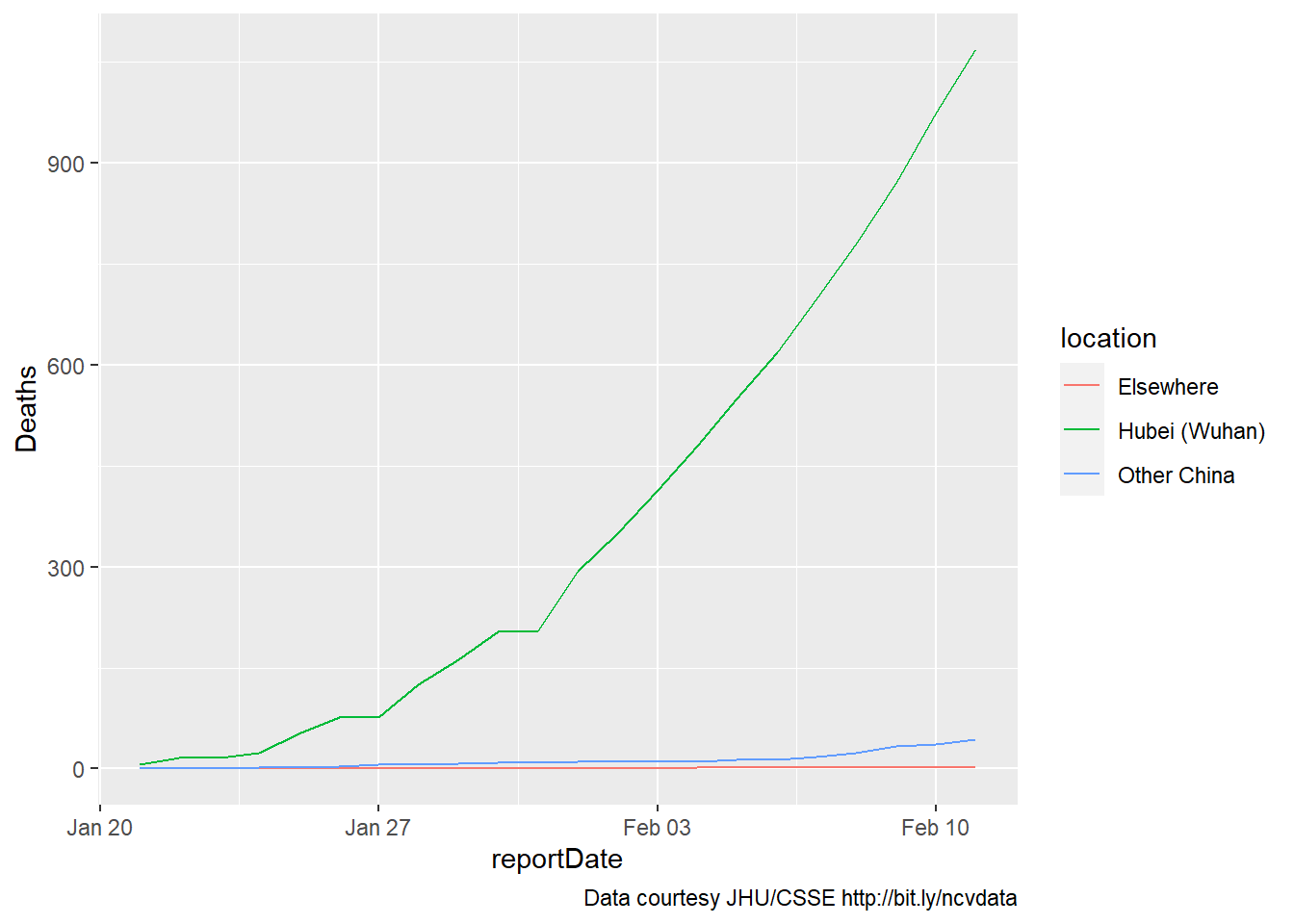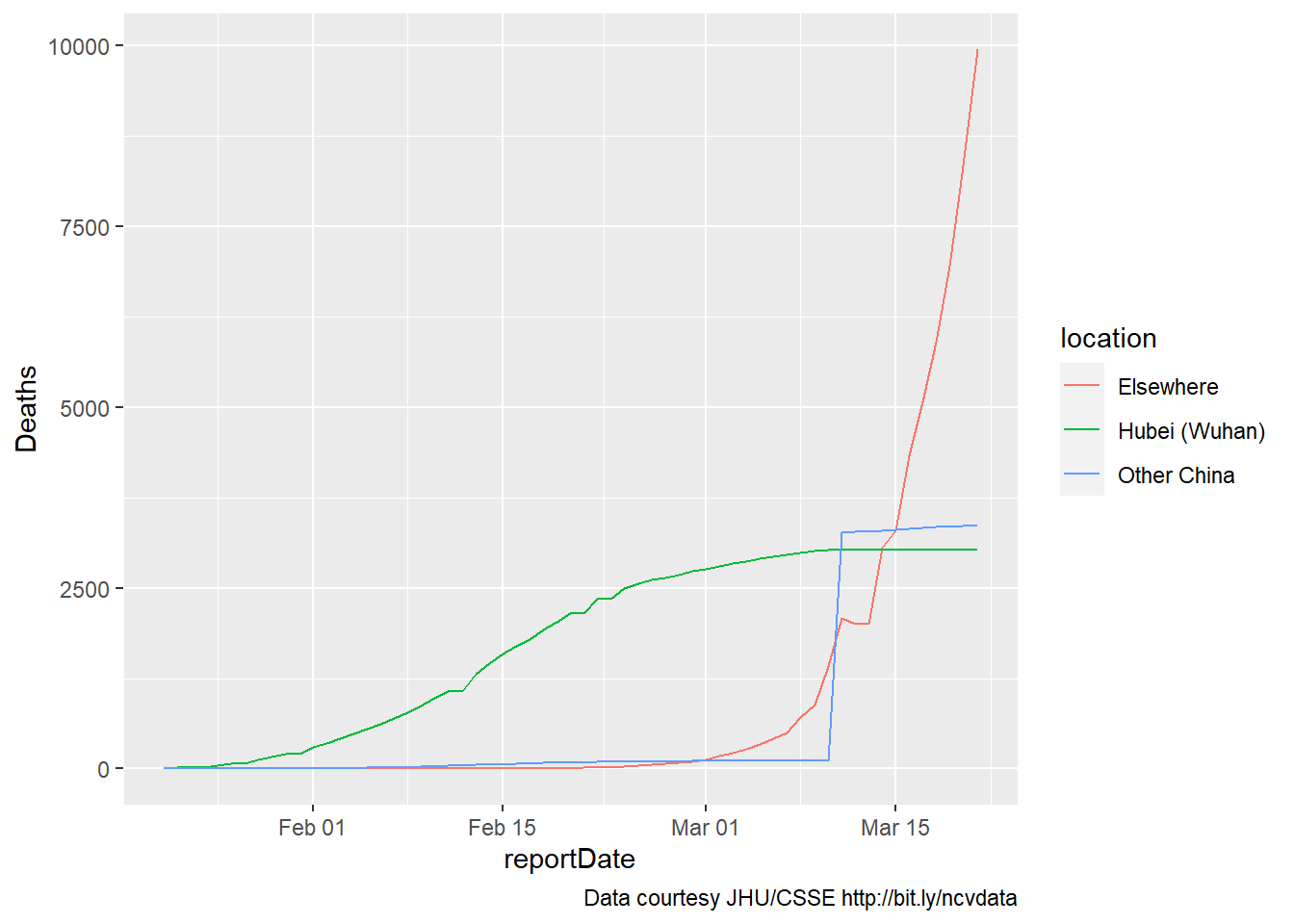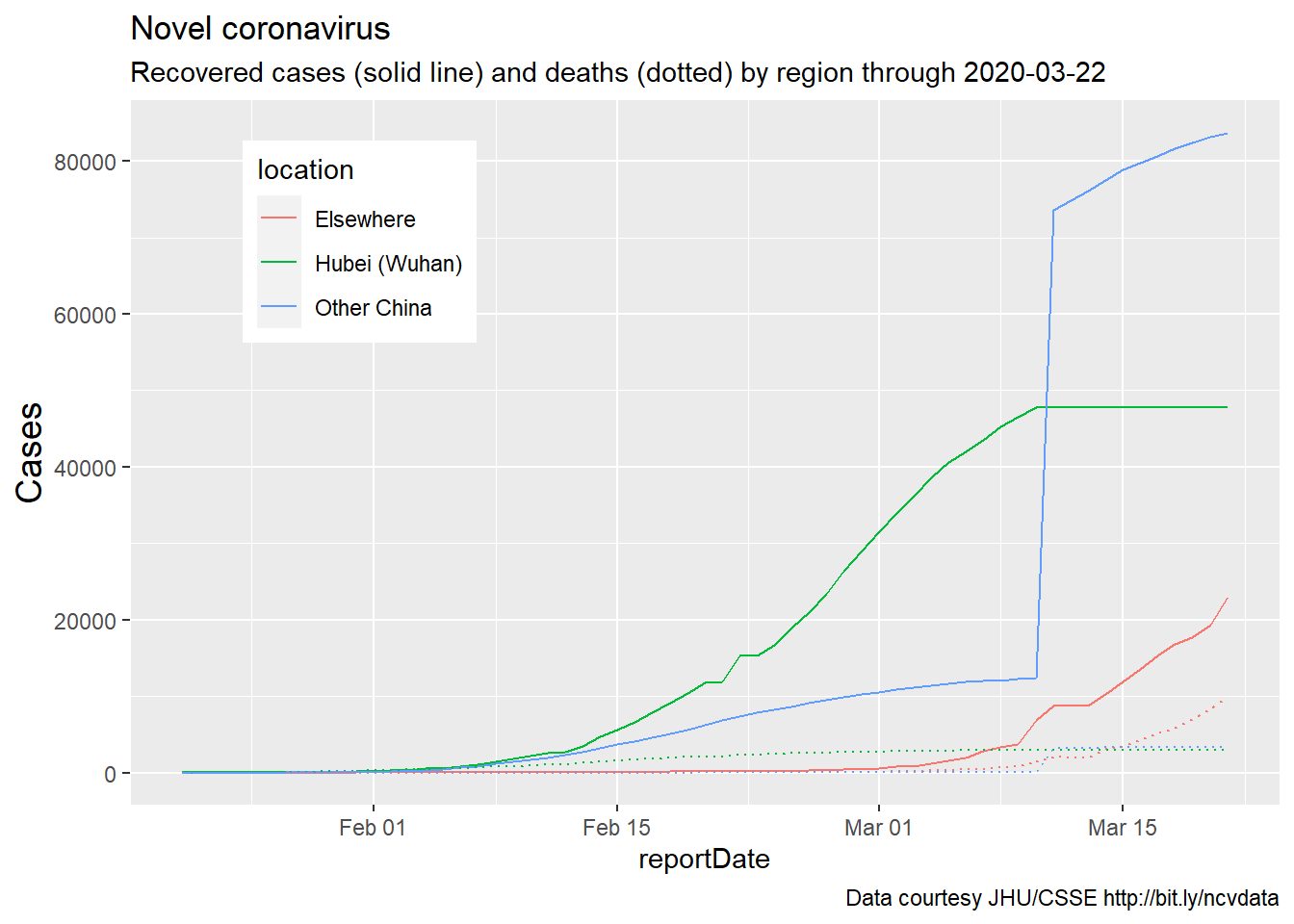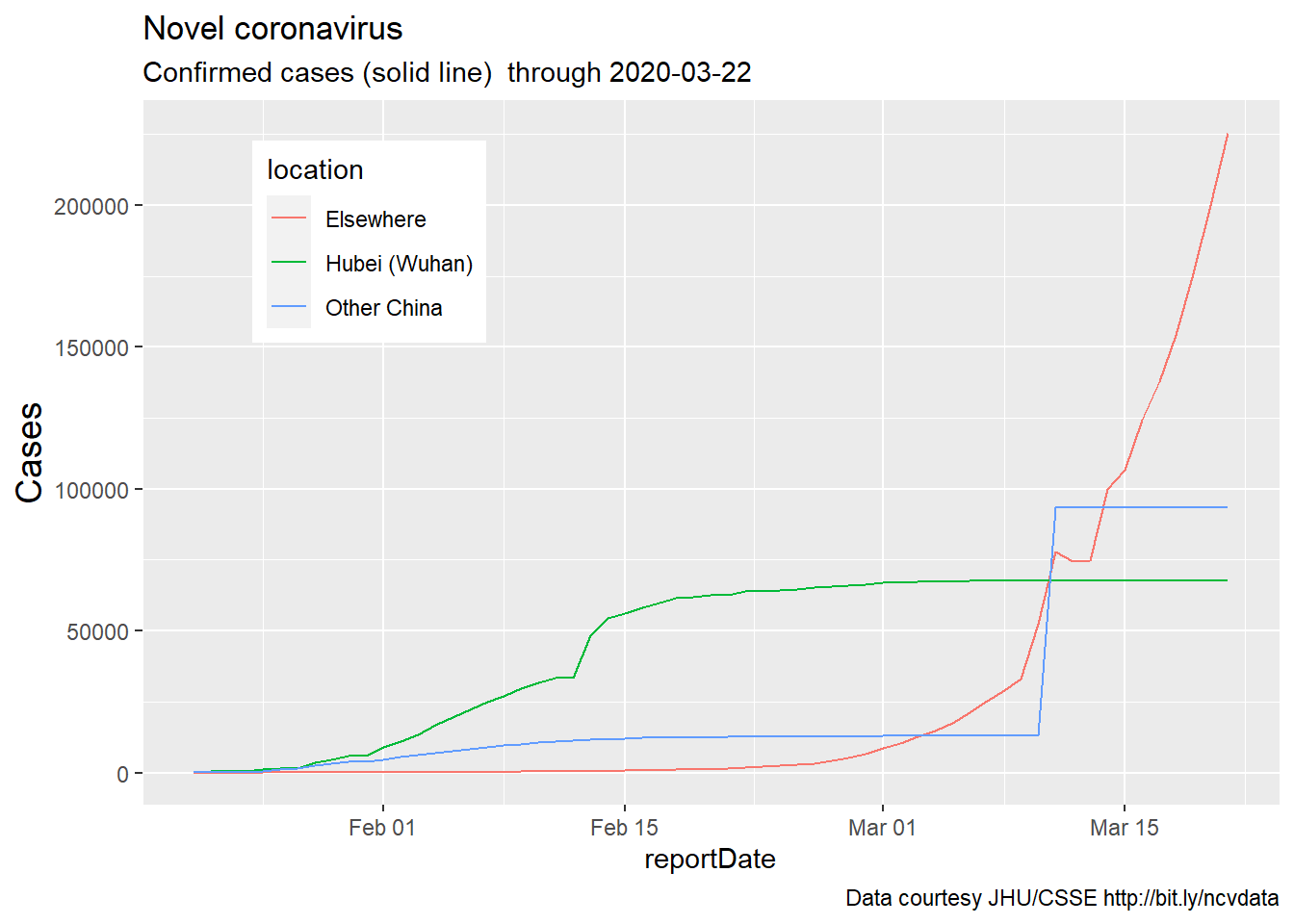In Winter 2020, as the COVID-19 pandemic began to take hold, I began
chronicling the course of the virus. What follows is an archive,
followed by a consideration of some possible new directions for COVID
analysis (suggested in Spring of 2021) - and finally, some other
datasets to continue (suggested in Fall 2021).
tracking the Novel Coronavirus (from Feb 2020)
Here, I want to consider a timely (but challenging) dataset.
The Novel Coronavirus is an emerging health crisis, particularly in
Wuhan (a Chinese city larger than New York City) and the surrounding
province of Hubei. It is not yet a threat in the United States - there
have, at this writing (02/11/20) been zero cases in Florida. Still,
tracking the spread of the virus - the unfolding number of people
infected and recovered, as well as the number of deaths - is a
fascinating exercise.
This is an educational script for students learning R with the
Tidyverse. It reads data provided by the Johns Hopkins Center for
Systems Science and Engineering (JHU/CSSE).
It was modified February 3 because of a new GoogleSheet link and altered
variable names, on Feb 5 because of a new URL for the data and
additional changes in the variable name for date, and Feb 7 to (a)
remove need for OAuth and (b) separate Wuhan from ‘other China.’ On Feb
9, additional data cleaning was performed and interactive plots were
added. On February 11, the code was rewritten to read files from a
Github repo rather than Google Sheets. Consequently, this does not use
an API or require authorization from Github.
# get list of files
filelist <- GET("https://api.github.com/repos/CSSEGISandData/2019-nCoV/git/trees/master?recursive=1") %>%
content() %>%
# there is probably a more efficient way to reduce this
# list to a set of filenames
flatten() %>%
map ("path") %>%
flatten() %>%
tibble() %>%
rename(filename = 1) %>%
filter(str_detect(filename,".csv") &
str_detect(filename,"daily"))
nsheets <- nrow(filelist)
rawGitFiles <- "https://raw.githubusercontent.com/CSSEGISandData/2019-nCoV/master/"
reading the data (Feb 2020)
The Novel Coronavirus data consists of a series of csv files in a Github
repository. This combines them into a single sheet in R.
# variables to retain or create
numvars <- c("Confirmed", "Deaths", "Recovered")
varlist <- c("Province/State", "Country/Region",
"Last Update", numvars)
# one cool trick to initialize a tibble
coronaData <- varlist %>%
map_dfr( ~tibble(!!.x := logical() ) )
# add data from files to tibble
for (i in 1:nsheets) {
j <- read_csv(paste0(rawGitFiles,filelist$filename[i]))
# if a variable doesn't exist in sheet, add it
j[setdiff(varlist,names(j))] <- NA
# datetime is formatted inconsistently
# across files, this must be done before merging
j %<>% mutate(`Last Update` =
parse_date_time(`Last Update`,
c('mdy hp','mdy HM',
'mdy HMS','ymd HMS'))) %>%
select(varlist)
coronaData <- rbind(coronaData, j)
}
head(coronaData)
## # A tibble: 6 x 6
## `Province/State` `Country/Region` `Last Update` Confirmed Deaths
## <chr> <chr> <dttm> <dbl> <dbl>
## 1 Anhui Mainland China 2020-01-21 22:00:00 NA NA
## 2 Beijing Mainland China 2020-01-21 22:00:00 10 NA
## 3 Chongqing Mainland China 2020-01-21 22:00:00 5 NA
## 4 Guangdong Mainland China 2020-01-21 22:00:00 17 NA
## 5 Guangxi Mainland China 2020-01-21 22:00:00 NA NA
## 6 Guizhou Mainland China 2020-01-21 22:00:00 NA NA
## # ... with 1 more variable: Recovered <dbl>
## tibble [2,119,144 x 6] (S3: tbl_df/tbl/data.frame)
## $ Province/State: chr [1:2119144] "Anhui" "Beijing" "Chongqing" "Guangdong" ...
## $ Country/Region: chr [1:2119144] "Mainland China" "Mainland China" "Mainland China" "Mainland China" ...
## $ Last Update : POSIXct[1:2119144], format: "2020-01-21 22:00:00" "2020-01-21 22:00:00" ...
## $ Confirmed : num [1:2119144] NA 10 5 17 NA NA NA NA 1 NA ...
## $ Deaths : num [1:2119144] NA NA NA NA NA NA NA NA NA NA ...
## $ Recovered : num [1:2119144] NA NA NA NA NA NA NA NA NA NA ...
cleaning (wrangling, munging) the data (Feb 2020)
Cleaning the data includes not just finding “errors,” but adapting it
for our own use. It’s generally time consuming, as was the case here.
The following letters refer to sections of the code below.
- a - fix a few missing values outside of China for province and
country
- b - the earliest cases, all in China, did not include country
- c - because province/state is included inconsistently, an
unambiguous place variable is created
- d - reportdate is standardized (above) and renamed
- e - in some cases, multiple reports are issued for each day. only
the last of these is used for each place.
- f - for dates where no data was supplied, the most recent (previous)
data are used
- g - values of NA for Deaths, Confirmed, and Recovered cases are
replaced by zero.
- h - Prior to Feb 1, 2020 reporting for US included only state, since
then, city and state. This drops the (duplicated)
province/state-only values beginning Feb 1.
coronaData <- coronaData %>%
# a
mutate (`Province/State` = case_when(
(is.na(`Province/State`) &
(`Country/Region` == "Australia")) ~ "New South Wales",
(is.na(`Province/State`) &
(`Country/Region` == "Germany")) ~ "Bavaria",
TRUE ~ `Province/State`)) %>%
mutate (`Country/Region` = case_when(
`Province/State` == "Hong Kong" ~ "Hong Kong",
`Province/State` == "Taiwan" ~ "Taiwan",
`Province/State` == "Washington" ~ "US",
# b
is.na (`Country/Region`) ~ "Mainland China",
TRUE ~ `Country/Region`)) %>%
# c
mutate(place = ifelse(is.na(`Province/State`),
`Country/Region`,
paste0(`Province/State`,", ",
`Country/Region`))) %>%
mutate(reportDate =
date(`Last Update`)) %>%
group_by(place,reportDate) %>%
# e
slice(which.max(`Last Update`)) %>%
ungroup() %>%
# fill in missing dates for each place for time series
# f
group_by(place) %>%
complete(reportDate = seq.Date(min(reportDate),
today(),
by="day")) %>%
fill(c(Confirmed,Deaths,Recovered,
`Country/Region`,`Province/State`)) %>%
# g
ungroup() %>%
mutate_if(is.numeric, ~replace_na(., 0)) %>%
# h
mutate(dropcase = ((!str_detect(`Province/State`,",")) &
(reportDate > "2020-01-31") &
(`Country/Region` == "Canada" | `Country/Region` == "US"))) %>%
# dplyr called explicitly here because plotly has taken over 'filter'
dplyr::filter (!dropcase) %>%
select(-c(`Last Update`,`Province/State`,`Country/Region`,dropcase))
head(coronaData)
## # A tibble: 6 x 5
## place reportDate Confirmed Deaths Recovered
## <chr> <date> <dbl> <dbl> <dbl>
## 1 Afghanistan 2020-02-24 1 0 0
## 2 Afghanistan 2020-02-25 1 0 0
## 3 Afghanistan 2020-02-26 1 0 0
## 4 Afghanistan 2020-02-27 1 0 0
## 5 Afghanistan 2020-02-28 1 0 0
## 6 Afghanistan 2020-02-29 1 0 0
write_csv(coronaData,"coronaData.csv")
eleven months later: the code still runs!
The above code runs without apparent error, and leads to a dataset of
251353 rows by 5 columns. Here’s a
quick peek (Note that I use the group_by and summarize functions to
collapse the file to one line per date):
coronaData %>% group_by(reportDate) %>%
summarize(Confirmed = sum(Confirmed)) %>%
head()
## # A tibble: 6 x 2
## reportDate Confirmed
## <date> <dbl>
## 1 2020-01-21 332
## 2 2020-01-22 557
## 3 2020-01-23 654
## 4 2020-01-24 941
## 5 2020-01-25 1771
## 6 2020-01-26 2795
shall we graph it? (Feb 2021)
So far, so good. Let’s plot the whole range. What do we see? This will
generate a quick graph in ggPlot which shows the global incidence of
confirmed cases.
coronaData %>%
group_by(reportDate) %>%
summarize(Confirmed = sum(Confirmed)) %>%
ggplot(aes(x=reportDate)) +
geom_line(aes(y=Confirmed))

too bad
According to the above graph, there have been no additional COVID cases
since mid-March or so. Too bad that the data aren’t right here - for us
and especially the world.
Exercise 8_1 How would we find the exact date when the file
stopped updating? In class, we’ll consider this question (we’ll use
pre-downloaded data to save time and computer resources). Use whatever
method you like for this - kludgy or clever - but you should describe
your results in explicit language or code so that anyone else would
get the same results.
what now?
I want to make sure that the rest of my code still works, so I’ll look
more closely at the valid data. I’ll generate a new variable
(‘firstbaddate,’ which sounds like a corny romcom), and filter by it.
When the code was written a year ago, the COVID outbreak was largely
contained to the Hubei province (which includes the city of Wuhan). So I
tried breaking down the data into three locations, breaking down China
into Hubei, other China, and the rest of the world.
And I generated summaries for three measures - Confirmed, Deaths, and
Recovered cases
firstbaddate <- '2020-03-22' # This line is added in 2021
coronaDataSimple <- coronaData %>%
filter(reportDate < firstbaddate) %>% # added in 2021
mutate(country = case_when(
str_detect(place,"China") ~ "China",
TRUE ~ "Other countries")) %>%
mutate(location = case_when(
place == "Hubei, Mainland China" ~ "Hubei (Wuhan)",
country == "China" ~ "Other China",
# what happens when this line is not commented out?
# why is it written this way?
# str_detect(place, "ruise") ~ "Cruise Ship",
TRUE ~ "Elsewhere")) %>%
group_by(location,reportDate) %>%
summarize(Confirmed = sum(Confirmed),
Deaths = sum(Deaths),
Recovered = sum(Recovered)) %>%
ungroup()
## `summarise()` has grouped output by 'location'. You can override using the `.groups` argument.
an initial plot (Feb 2020)
The first plot is simple, including data for only deaths. A caption is
added to show the source of the data. Here’s what the data looked like
last February 11:
myCaption <- " Data courtesy JHU/CSSE http://bit.ly/ncvdata"
oldData <- coronaDataSimple %>%
filter(reportDate < '2020-02-12')
coronaPlot0 <- oldData %>%
# filter(reportDate < '2020-02-12')
ggplot(aes(x=reportDate)) +
geom_line(aes(y=Deaths, color = location)) +
labs(caption = myCaption)
coronaPlot0

five weeks later (Mar 2020)
About five weeks later our data would stop updating. But the world had
already changed: Here’s the same graph, through March 21, 2020:
coronaPlot0 <- coronaDataSimple %>%
ggplot(aes(x=reportDate)) +
geom_line(aes(y=Deaths, color = location)) +
labs(caption = myCaption)
coronaPlot0

It’s apparent that the coding for Wuhan versus the rest of China is off
for some of the newer data, as one of these increases while the other
reaches a plateau. Still, the overall picture is clear.
adding recovered cases (code from Feb, data through Mar 2020)
Similar results are obtained if we examine two other populations of
interest, recovered and confirmed cases. Here, recovered cases and
deaths are included on a single plot, as these are roughly on the same
scale. Additional changes to the graph are self-evident.
mySubtitle <- paste0(
"Recovered cases (solid line) and deaths (dotted) by region through ",
firstbaddate)
# (month(today())), "/",
# (day(today())),"/",
# (year(today())),".")
myCaption <- " Data courtesy JHU/CSSE http://bit.ly/ncvdata"
coronaPlot1 <- coronaDataSimple %>%
ggplot(aes(x=reportDate)) +
geom_line(aes(y=Recovered,
color = location),
linetype = "solid") +
geom_line(aes(y=Deaths,
color = location),
linetype = "dotted") +
theme(axis.title.y =
element_text(angle = 90,
vjust = 1,size = 14),
legend.position = (c(.2,.8))) +
labs(title = "Novel coronavirus",
subtitle = mySubtitle,
y = "Cases",
caption = myCaption)
coronaPlot1

plotting confirmed cases (Feb-Mar 2020)
Finally, confirmed cases are plotted on a different scale:
mySubtitle <- paste0(
"Confirmed cases (solid line) through ",
firstbaddate)
# (month(today())), "/",
# (day(today())),"/",
# (year(today())),".")
myCaption <- " Data courtesy JHU/CSSE http://bit.ly/ncvdata"
coronaPlot1 <- coronaDataSimple %>%
ggplot(aes(x=reportDate)) +
geom_line(aes(y=Confirmed,
color = location),
linetype = "solid") +
theme(axis.title.y =
element_text(angle = 90,
vjust = 1,size = 14),
legend.position = (c(.2,.8))) +
labs(title = "Novel coronavirus",
subtitle = mySubtitle,
y = "Cases",
caption = myCaption)
coronaPlot1

status (Feb 2021)
The code above works ok, but the March 2020 data need further cleaning,
and no new data have been added in 11 months. In that time, as the
pandemic has spread, numerous other resources for tracking COVID have
been developed, most of which are far more sophisticated and less
cumbersome than the code above.
There are new datasets, new R packages, and, perhaps most importantly,
new questions that we might consider about variables such as vaccination
rates, test-positivity rates, and hospital capacity.
An assignment
Please study and be prepared to briefly discuss one of the following
packages or datasets:
(Fall 2021) COVID long-haulers aren’t the only one’s suffering from COVID fatigue
For those who want to focus on something else, please look at either
one or more datasets in the mdsr package.
and/or one of the (1500) datasets described on still another github
page, i.e., vincentarelbundock/Rdatasets: A collection of datasets
originally distributed in R packages
(github.com)
For the GitHub pages, review the README.md section to get a sense of
what is available in the data. How current is it (when was the code last
modified?). How popular is it (look at the number of ‘watches’ ‘stars’
and ‘forks’ in the upper right hand corner of the webpage)? How buggy is
it (look at the ‘issues’ tab, then look at ‘Open’ and ‘Closed’ issues?
Is it worth looking further at this library)?
For the other datasets - what could you study in these data? Why would
it be cool to look at this data more closely? You’ll be doing a more
thorough data pitch in a few weeks - this is just a warm-up. But be
prepared to share your thoughts in class on Wednesday.
how to create new knowledge
One thing to keep in mind as we move forward is that, despite the fact
that hundreds if not thousands of statisticians, data scientists,
epidemiologists, policy makers, and journalists have looked at COVID
data, there are still unanswered questions.
For example, here in Florida, there was recently some controversy as
the Governor chose to disperse COVID vaccinations at Publix
pharmacies; the controversy arose, in large part, because poorer
communities (including those in the Western part of Palm Beach County)
appear less likely to have a Publix supermarket. Is it the case that
there is a relationship between COVID disease rates and the number of
Publix/per capita by city or zip code (Florida data by Zip code is
available at
https://covid19-usflibrary.hub.arcgis.com/datasets/)??)
If so, what would this tell us?
In data science, we can often create new knowledge by putting together
two data sources which haven’t been combined before, together with an
interesting and potentially important question.




